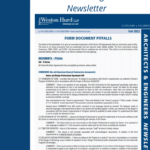Posted on
January 17, 2023
in
Business,
Employment,
News

January 17, 2023 As a follow-up to Weston Hurd’s January 9, 2023, news alert regarding the Federal Trade Commission’s (FTC’s) proposed rule which would nullify nearly all non-competition agreements, and as identified in that alert, the U.S. Chamber of Commerce (Chamber) has indicated that it will likely bring suit against the FTC if its proposed […]
Posted on
January 11, 2023
in
Business,
Employment,
News

January 9, 2023 On January 5, 2023, the Federal Trade Commission issued a proposed rule which would, in effect, nullify all non-competition agreements (non-competes) between businesses and their employees or independent contractors based on the determination that non-competes constitute unfair methods of competition. See Non-Compete Clause Rulemaking | Federal Trade Commission (ftc.gov). If adopted in […]
Posted on
December 29, 2022
in
Insurance,
News

Ohio Supreme Court Finds That Insurance Policy Does Not Cover Ransomware Attack, As Computer Software Cannot Experience Direct Physical Loss Or Physical Damage Required Due To The Lack Of A Physical Existence. In a December 27, 2022 decision, the Ohio Supreme Court, in EMOI Servs., L.L.C. v. Owners Ins. Co., Slip Opinion No. 2022-Ohio-4649, issued […]
Posted on
December 12, 2022
in
Insurance,
News

Ohio Supreme Court Finds No Business Income, Property Damage, Extra Expense, Or Civil Authority Coverage for Covid – as the Mere Presence of Covid In the Community or on Surfaces at Business Premises or via Infected Persons Being On the Premises Does Not Constitute Physical Loss or Damage to Covered Property In a December 12, […]
Posted on
November 3, 2022
in
Employment,
Insurance,
News,
Real Estate

Weston Hurd is honored to be recognized in the U.S. News-Best Lawyers® 2023 “Best Law Firms” rankings. Overall, Weston Hurd garnered 12 practice rankings, including a National ranking in Insurance Law and Tier 1 Metropolitan rankings in Construction Law (Columbus), Insurance Law (Cleveland), Litigation-Insurance (Columbus), and Personal Injury Litigation-Defendants (Cleveland and Columbus). According to Best Lawyers, “The U.S. […]

Weston Hurd is pleased to welcome back Paul M. Shipp who rejoins the firm as a Partner. Paul began his legal career as an Assistant Cuyahoga County Prosecutor and most recently, was the founder and managing member of The Paul Shipp Law Firm. Paul is a seasoned litigator whose experience includes white collar criminal defense, criminal […]

The intent of this issue of the Architects and Engineers Newsletter is to give an overview/comparison of the Owner A/E Agreements that are commonly used in Ohio. The focus is on those provisions that are problematic and can become major liability pitfalls. The form documents include Consensus, DBIA, OFCC, and EJCDC. AIA documents that are […]

Weston Hurd is pleased to announce that a record number of attorneys are recognized in The Best Lawyers in America© 2023 including David Patterson as “Lawyer of the Year” in Construction Law. Best Lawyers® uses a methodology “…designed to capture, as accurately as possible, the consensus opinion of leading lawyers about the professional abilities of their colleagues within the same geographical area […]







